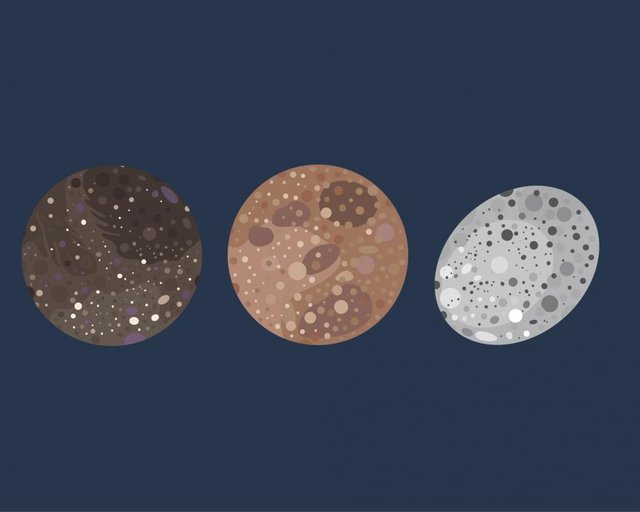
The planets dwarfs and the millions of other bodies dotting the Kaiper belt in the gloomy periphery of the solar system are in themselves a strange commodity, but among them are the most amazing cheshtits.
First of all, they are still poorly studied and their composition is predominantly supposed to be icy and loose, most likely comet-like. It is believed that they are kept as in the freezer traces of the substances from which billions of years ago formed our planetary system.
On December 28, 2004, scientists from two US observatories - one in Hawaii, the other in California - found the body receiving catalog number 2003 EL61. Because of its appearance on the Christmas holidays, the object for some time bears the unofficial nickname "Santa Claus", but was later named Haumea - the name of the Hawaiian goddess of motherhood.
Between 50 and 35 times farther from the sun
than the Earth, the Haumea has a diameter roughly as Pluto, the former ninth planet in the Solar System. But the shape of the new planetoid resembles a "thick, jagged cigar," according to one of his researchers, Mike Brown of the California Institute of Technology.
The first surprise, then, "Santa Claus" is to scientists, is that its brightness rises and decreases by 25% every two hours. Accounts show that a spherical body of such dimensions and speed of rotation should break. So it comes to the conclusion that the planet is rather elongated and makes a turn around its axis for nearly four hours - which is a record for our system. So every two hours shows us one of its narrow edges and a corresponding minimum in the glow.
The strange shape of the Haumea is the result of her wild spin
Centrifugal forces stretch it along the equator - like the Earth, which is also not an ideal sphere.
Surfing on its surface is also something special - there is a big difference between the weight of the objects at the local poles compared to that of the equatorial belt.
But the shape and dervish speed of rotation are not the strangest, with which the Haumea annoys the curiosity of astronomers. As well as a goddess, she is accompanied by a satellite ensemble. But the eccentric aristocrat has a personality that accompanies his character.
Not a few Caipera bodies that are known to have satellites. For most of them, they are supposed to have caught these smaller bodies when they meet in space. Some kind of "nobles" are surrounded by mercenaries.
But there is no such thing around Humea, her companion Hiaca is too small to get caught. In addition, scientists are confident that it is made entirely of water ice. Thus, the hypothesis is that another body has ever hit the Haume and has scattered pieces in the vicinity.
The giant planet is large enough for its various ingredients to be distributed according to its mass - the heavy rock fragments to the center, the lighter ice - on the surface. At the impact of the unknown guest, the ice broke into space, and one of the pieces remained in orbit around the Haumean.
Follow-up observations set the orbit of the Hawaiian goddess but gave birth to another great surprise, a second companion called Namaka. With which Haumea confidently occupies an absolutely unique niche -
no other Kaiper object with more than one satellite
The history of the planet raises interesting hypotheses for scholars. The Haumea was relatively large and was apparently struck by something ragged. But the great Keiper bodies are very rare. So it is either a casual but very unlikely blow, or there was a lot more big fish in the Kaiper belt. Their disappearance remains a mystery - perhaps they have broken into such clashes, but that is not certain.
Haya and Namak are not the only fruits of the ancient clash. In orbits close to that of Haumea, shorter debris is flying in the Kaiper belt. Their dimensions are 150 km to a fist.
So the name of the planetary dwarf can not be better suited. Haumea is the Hawaiian goddess of motherhood and birth, and mother of a bunch of other Hawaiian deities, including Hiaika and Namaka. The myth also claims that her children were born of pieces of Haumea's flesh.
So far, ten of Haumea's largest "children" have been found scattered around the Kaiper belt. They are expected to be detected even, even among the already discovered other bodies - now the orbits are simply modeled. Scientists have little to make sure that most bodies in the girdle are just debris. And the study of interplanetary collisions on their results can also provide valuable data on the birth of the Earth-Moon system, which is also created by the impact of cosmic bodies.
One small correction: isn't Kuiper rather than Kaiper?
Downvoting a post can decrease pending rewards and make it less visible. Common reasons:
Submit
Thanks for using eSteem!
Your post has been voted as a part of eSteem encouragement program. Keep up the good work! Install Android, iOS Mobile app or Windows, Mac, Linux Surfer app, if you haven't already!
Learn more: https://esteem.app
Join our discord: https://discord.gg/8eHupPq
Downvoting a post can decrease pending rewards and make it less visible. Common reasons:
Submit